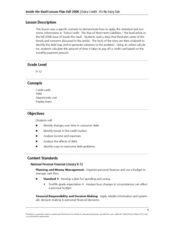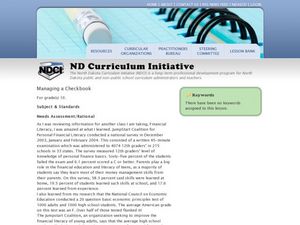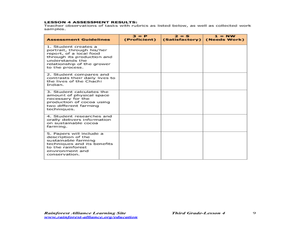Conneticut Department of Education
Personal Finance Project Resource Book
Balancing a budget, paying taxes, and buying a home may feel out of reach for your high schoolers, but in their adult years they will thank you for the early tips. A set of five lessons integrates applicable money math...
Curated OER
Extra Credit: It’s No Fairy Tale
Students discuss their knowledge of payday loans and credit cards. In this Economics lesson, students complete a read an article and Q&A activity in groups, and play a vocabulary bingo game and a quiz game on payday loans. Students...
Curated OER
Money Management Part III: Savings Accounts and Cash vs. Credit
Help your class understand the importance of saving and managing their money. Here is part three to a unit on credit, cash, and savings. Learners discuss savings accounts and the idea that a budget plan can help them avoid costly credit...
Federal Reserve Bank
To Rent-to-Own or Not to Rent-to-Own?
Explore the key elements of a contract with your young adults, and delve into the features and unique benefits of a rent-to-own contract through discussion and worksheet practice.
Federal Reserve Bank
Cash the Check and Track the Dough
From checking and savings accounts to learning the importance of maintaining records and balancing a bank account, prepare your learners to become financially independent and savvy adults, and explore all the intricacies of owning a bank...
Curated OER
Managing a Checkbook
How do grown ups do it? Teach your upper graders the ins and outs of personal finance by having them use their algebra skills to balance a checkbook. They examine the financial side of math, set up a checking account, and balance their...
Visa
Hall of Fame Lesson Module — Financial Football
Kick off an engaging review on personal finance with an online football game. Financial Football incorporates both football strategies and economic knowledge in an interactive format, allowing future CFOs to answer a variety of...
Curated OER
Weight Game
Students estimate and compare grapefruit weights. In this weight measurement and literacy lesson, students listen to the story Nate's Big Hair and the Grapefruit in There, then estimate the weight of a grapefruit after holding it....
Visa
Rookie Lesson Module — Financial Football
Score a touchdown with an exciting game of financial football! Middle schoolers choose their favorite teams and play a virtual game of football as they answer various questions about economics.
Curated OER
ADULT ESOL LESSON PLAN--Consumer Education
Students research the various establishments where one can buy clothing and the cost of those purchases. With the help of a lengthy vocabulary list, magazines and newspapers, students name and identify the cost of basic items of clothing.
PLS 3rd Learning
Find the Fees
Before teens head off to college or the workforce, they need to understand the world of credit. Here, they look online at credit card agreements to find hidden fees and rates. The online activity guides them through and even assesses...
Curated OER
ADULT ESOL LESSON PLAN--Skills Necessary to Listen, Speak, Read and Write Effectively
Students, referring to the alphabet and numbers, practice stating, reading and writing letters and numbers. As they write each letter and number they say each one as well. They find examples of each one in a newspaper or magazine ad.
Curated OER
ADULT ESOL LESSON PLAN--Concepts of Time and Money
Students identify different denominations of United States currency and symbols associated with money and reading prices. In addition, in pairs they identify examples of currency from newspapers and magazines.
Curated OER
Analyze This
Students gain practice in the analysis of various types of graphs common in daily life. These examples often use graphic images like charts, graphs, tables, and pictures to supplement learning.
Curated OER
Equadorian Rainforest: The Tropical Supermarket
Students study the concept of sustainable agricultural practices through cocoa farming and the lives of the people who are the producers. Students watch a slide show and read a story which helps them understand the origins of chocolate,...
Curated OER
ADULT ESOL LESSON PLAN--Concepts of Time and Money.
Students identify/recognize types of currency in the United States. In addition, they view the symbols associated with money and practice reading prices (dollar/cent signs, decimal point, etc.).
Agriculture in the Classroom
Pumpkins... Not Just For Halloween
Celebrate fall with four pumpkin themed hands-on activities! After learning about pumpkins, scholars complete two activity sheets that reinforce estimation and word problems. They then plant pumpkin seeds and bake a pie in...
Curated OER
A Fraction of the Possibilities
Students review the conversion of fractions to decimals, develop strategies to compare fractions perform complex calculations using ratio techniques similar to the construction of fractions.
Curated OER
Consumer Education
Students, while examining an intense list of vocabulary terms on types of money, change and simple foods, name and state the cost of food items in supermarkets, grocery stores and flea markets with flash cards and newspaper ads.
Curated OER
Weathervanes in the Wind
Learners investigate wind and weather by creating a weathervane. In this environment lesson, students identify the purpose of a weathervane and observe weathervanes in action on their campus. Learners create a weathervane and...
Curated OER
Math: Football League Statistics
Students examine a soccer league final standings chart and then answer 12 questions based on the information provided. They calculate some answers in both fractions and percentages.
Curated OER
Speaking and Listening
In this basic mathematics activity, students follow instructions as given to play a math game. They listen for detail in explanations and narratives in various contexts. Students also provide feedback and confirmation of what they...
Curated OER
Math: Musical Patterns
Students employ their five senses to interpret and duplicate instrumental patterns. Following the teacher's patterns, students clap their hands and later use instruments such as bells, triangles, or cymbals to create their own "songs."






















